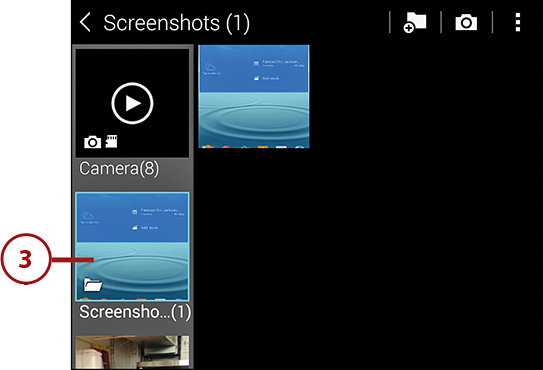11. Capturing and Managing Photos
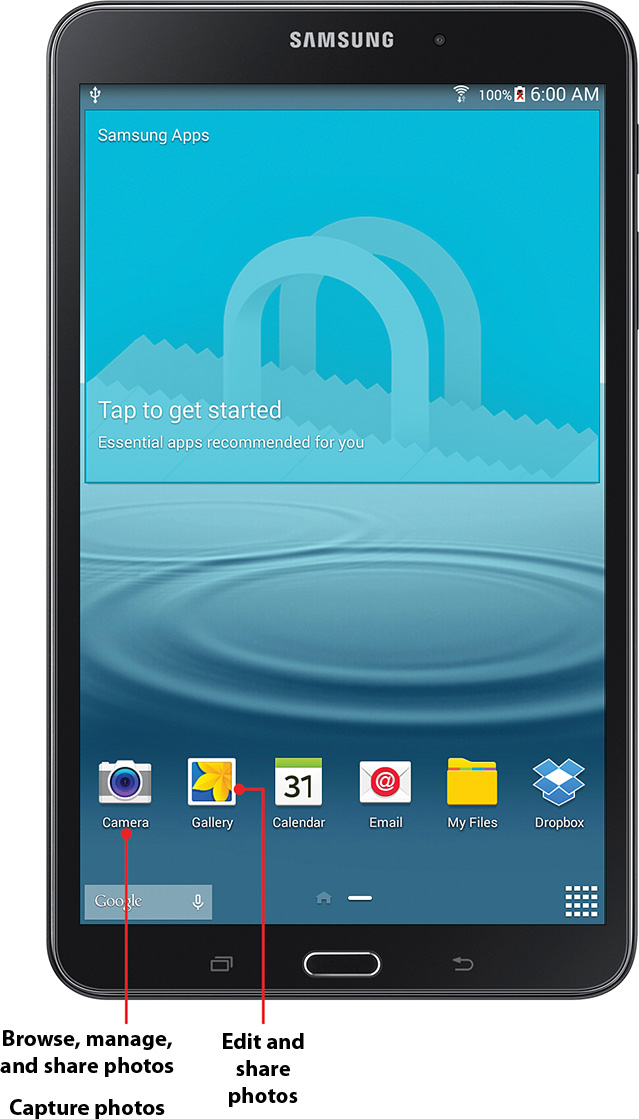
In this chapter, you find out how to capture photos and screenshots, share photos via email and slideshows, and view and manage photos with Gallery:
![]() Editing and sharing images
Editing and sharing images
![]() Performing screen captures
Performing screen captures
Along with transferring images from other sources, such as your computer or microSD card, to your Galaxy Tab 4, you can also take high-quality photos with your Tab 4, which can house thousands of photos organized in categories. You also have the capability to take screenshots of the Tab’s interface.
Your Tab’s high-resolution screen offers a great way to showcase photos to friends and family, but you don’t have to stop there. You can also use Photo Editor and Photo Studio, which are accessible from Gallery, to perform basic photo edits. You can even share pictures via AllShare, Bluetooth, Gmail, Picasa, and more.
Using the Camera
All Galaxy Tab 4 models use a 3.0 megapixel rear-facing camera located on the back of the device to take photos along with a 1.3 megapixel front-facing camera that you can use for self-portraits.
Taking a photo can be as simple as choosing a subject, composing your shot, and pressing a button. The Galaxy Tab 4 is also equipped with some helpful features commonly found on dedicated photo cameras, including shooting modes, scene modes, manual exposure, white balance, flash, manual exposure, and ISO settings.
1. On the Home screen, swipe from right to left to open the second page on the Home screen, and then tap Camera.
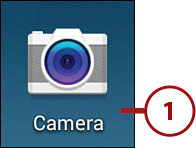
2. If you have a microSD card inserted, you can either tap OK to change the storage settings to the SD Card or tap Cancel to use your Tab’s storage to store photos and videos.
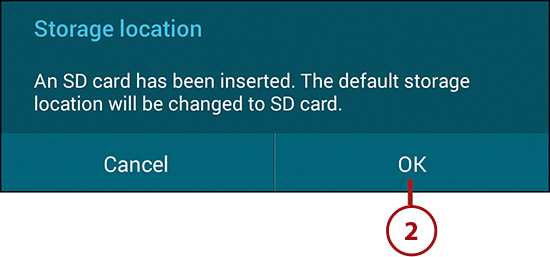
3. Tap the right arrow icon to customize camera quick settings.
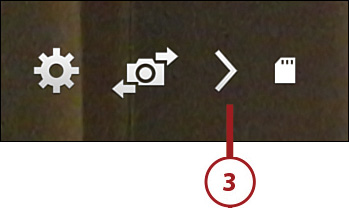
4. Five icons appear underneath the Settings icon so you can customize the first five camera setting shortcuts in the menu: Timer, Brightness Control, Recording, Share, and Viewfinder Ratio. The Viewfinder Ratio features changes the display proportion of the photo on the screen between 16:9 (the default) and 4:3, but does not change the size or proportion of the photo itself.
5. You can swap out these settings with others that appear when you tap and hold a shortcut icon for a second or two. After you release your finger, the list of settings appears in the window underneath the five setting shortcut icons. Just drag a new setting on top of an old one to replace it.

6. Tap the Back touch button after you’ve finished replacing your quick setting icons.
7. Change the scene mode by tapping the Mode button.
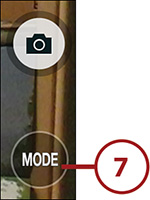
8. Swipe back and forth between the tiles; the selected tile appears at the top of the tile stack and a description of the mode appears above the tile for a few seconds. The default mode is Auto.
9. Tap the mode tile you want to use.
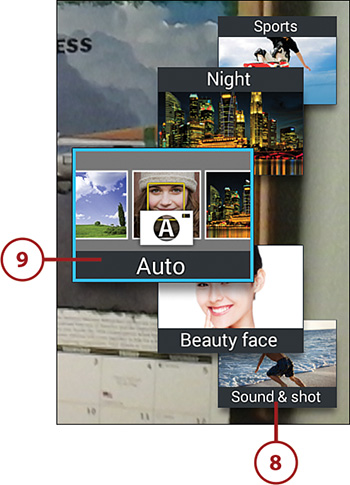
10. Tap the Settings icon.

11. Tap the Settings icon in the window.
12. Tap Location Tag to enable or disable GPS tagging of the photos you capture. Embedded GPS information can come in handy if you use a photo-editing and managing application such as iPhoto 9 and later, which enables you to use the location information to manage and showcase photos.
13. Tap Review to turn the review screen off or on. If Review is turned on, then you see a preview of the photo or video you just shot in the Review screen.
14. Tap Volume Key to determine if the volume key acts as the zoom key or the Camera/Recording key. The default is the zoom key.
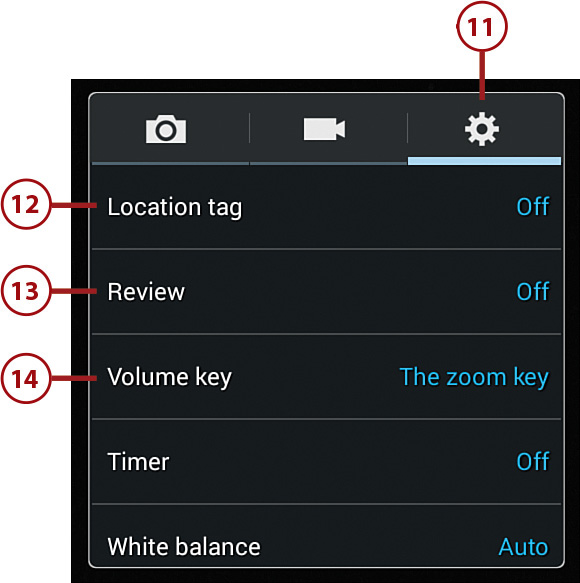
15. Tap Timer to designate how long the Tab should wait before the camera takes a picture. This is great when you want to set up the shot and then place yourself in the frame.
16. Tap to adjust the white balance for the camera. The white balance features help accurately reproduce colors when you are shooting in various lighting situations so that neutral colors, such as white and gray, are truly neutral and all colors are rendered without undesired color casts.
17. Swipe down the list to view more options.
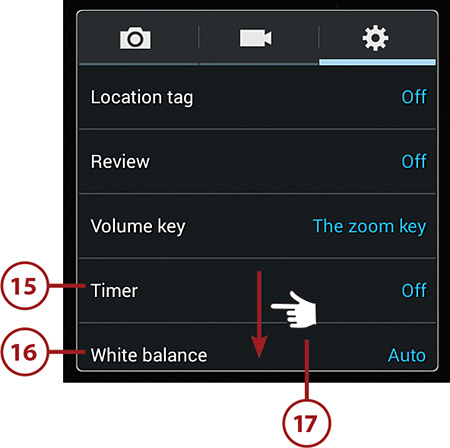
18. Tap Guidelines to enable or disable an onscreen grid that can help you with composition.
19. Tap Contextual Filename to enable or disable the ability to include your Tab 4 GPS information in the photo or video filename.
20. Tap Save as Flipped to horizontally flip a photo taken with the front camera, which eliminates the “mirror” effect.
21. An image that is too light or too dark degrades the appearance of your photos. To take full advantage of the camera feature of the Tab 4, you must adjust the brightness level for various bright or dark lighting conditions. Tap Brightness.
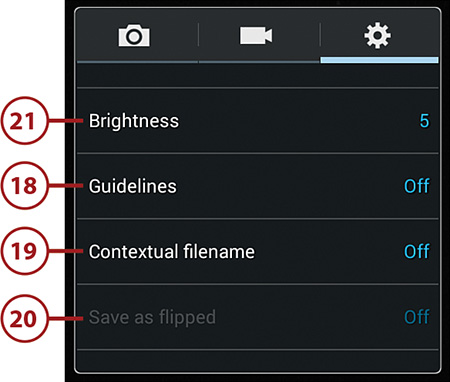
22. Drag the brightness level up to achieve a proper level in a low-light shooting environment, or drag it down for a very bright shooting environment.
23. When you’re finished changing the exposure level, the brightness slider bar disappears after a couple of seconds. Return to the Settings menu by tapping the Settings icon as you did in Step 9.
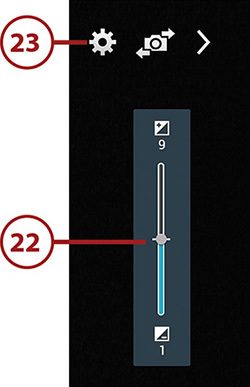
24. Swipe down the list until you can tap Storage to determine whether the photos you capture are stored on an optional memory card or on your Tab.
25. Tap to reset the Camera settings to the default settings.
26. Tap to get some quick onscreen help for the Camera app.
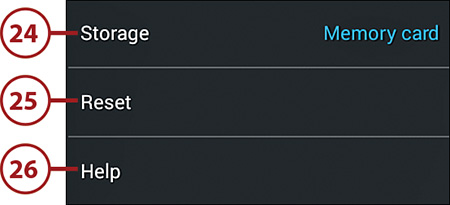
27. Tap the Camera icon.
28. Tap to set how the camera measures or meters the light source. This setting determines how the camera factors light in a scene to achieve the proper exposure.
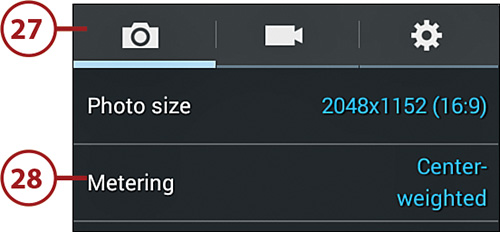
29. Return to the Viewer by tapping the Back touch button.
30. Tap to switch between the rear-facing and front-facing cameras.
31. Compose the subject in the Viewer. By default, Camera automatically focuses on what is in the center of the Viewer.
32. Hold your finger on the Camera button, level the shot, and then remove your finger from the button to capture the image. A thumbnail of the image appears in the Image Viewer.

33. Tap the Image Viewer to review the image you just captured. You can also access your photos by tapping the Gallery icon under Applications from any Home screen.

Navigating Image Viewer
Image Viewer provides a quick-and-easy way to review the photos that you have just taken. It also enables you to quickly share your pictures as soon as you capture them or set them as wallpaper. You can also edit and delete unwanted photos in Image Viewer.
As soon as you take a picture, a thumbnail of that photo appears next to the camera button. You can tap that thumbnail to review the picture you have taken and browse other photos.
1. Tap the Image Viewer to review the image.

2. The image opens full screen, the controls appear, and then they fade away. Tap the middle of the screen to access the controls again.
3. Tap the AllShare Play icon to share your photo with another device that has an AllShare Play account.
4. Tap the Share Via icon to access many options for sharing your photos through services such as Group Play, ChatON, Dropbox, Wi-Fi Direct, Picasa, Google+, Flipboard, Hangouts, Bluetooth, Gmail, and email. The button next to the Share Via icon displays the last option you used to share photos.
5. Tap to delete the currently displayed photo.
6. Flick the image from left to right or tap the thumbnail representations of photos at the bottom of the screen to navigate through all the photos you have captured.
7. Tap the Menu icon to access more options.
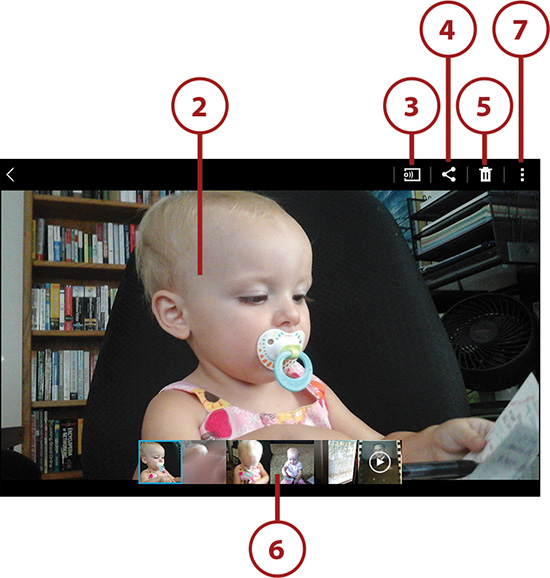
8. Tap Favorite to add the photo to your Favorites album. If the photo is already one of your favorites then tap Unfavorite to remove the photo from your Favorites album.
9. Tap to begin a slideshow of your photos. After the slideshow begins, you can tap anywhere onscreen to end the slideshow.
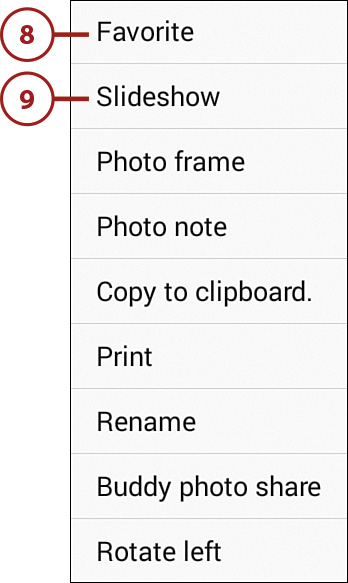
10. Tap to edit your photo and place it within a frame image.
11. Tap to edit your photo to make it look like the back of a printed photo.
12. Tap to copy the current image to the clipboard.
13. Tap to print the photo, such as to a Bluetooth printer.
14. Tap to give the currently displayed image a new name.
15. Tap to share the photo using face detection.
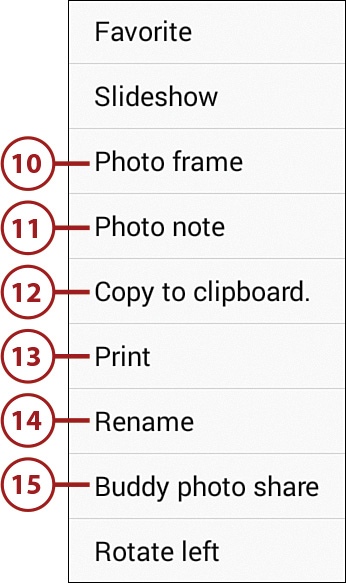
16. Swipe down the list to view more options.
17. Tap to rotate the photo to the left.
18. Tap to rotate the photo to the right.
19. Tap to crop the currently displayed photo.
20. Tap Set As to set the current picture as a contact photo, Home and lock screens, lock screen, or wallpaper.
21. Tap to view details about the photo including the time it was taken, aperture, and exposure settings upon capture.
22. Tap to view and change more Camera app settings.
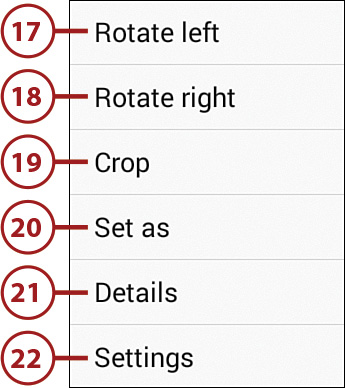
23. Close the menu by tapping the Back touch button.
24. With the menu closed, double-tap the image to enlarge it. You can double-tap it again to return it to its normal size. You can also touch the screen with two fingers and then move them apart to enlarge an image.
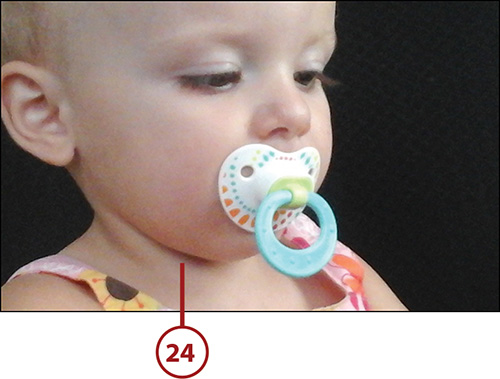
25. Tap the Back touch button to return to the Camera app and take more pictures.
Tips for Capturing Photos
Shutter lag is the amount of time that elapses between your press of the shutter release button and the moment the picture is captured. A longer shutter lag is common among most compact cameras and also the Galaxy Tab 4. What this means for you is that is that you have to be particularly mindful of timing your shots when recording moving subjects. Shutter lag can cause you to miss out on a key action if you do not anticipate the shot.
One important thing to know about your Tab is that the shutter does not fire as you place your finger down on the Camera button; the shutter fires when you lift your finger off the button. Use this knowledge to your advantage by pressing your finger on the shutter button and holding while you frame the shot and focus on an object about the same distance as where the subject will pass, to anticipate the shot, and then lift your finger. This means you need to hold your Tab completely still for a little bit longer. Anticipating moving subjects to capture dynamic, moving shots can take some practice.
The Galaxy Tab’s slow shutter makes it prone to producing blurry photos if you do not remain perfectly still during capture. Even the smallest movement can have an adverse effect on your photographs; this is especially true in low-light situations. A photo might appear to be fine when you review it on the Tab display, but when you download it and view it on a larger display, you can see the problem.
Working with Gallery
Gallery offers a more robust photo and video management system than Image Viewer, but it has similar options for viewing, sharing, and editing photos.
Manage Photos with Gallery
By default, you can access the Gallery icon by flicking the main Home screen from left to right, or you can access it from the Apps menu.
1. Tap Gallery on the Home screen.
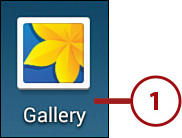
2. Content is arranged in categories/albums. If you have downloaded videos, such as video podcasts or recorded videos, with your Tab and transferred images from your computer, they are in here, too. Tap the Camera icon to access the Camera feature from Gallery.
3. Tap the Albums menu to group your photos and videos in other ways. The name of this particular menu changes depending on which grouping method you have selected.

4. Tap the Albums option to arrange photos based on the folder in which they are stored.
5. Tap All to arrange all photos on the Galaxy Tab 4 based on the time they were captured from newest to oldest; the newest photos appear at the top of the screen.
6. Tap Time to arrange photos based on the time they were captured. The most recent photos appear in the row at the bottom of the screen.
7. Tap Locations to arrange photos based on their GPS location.
8. Tap People to arrange photos based on pictures where a face was detected.
9. Tap Favorites to arrange photos in your Favorites album.
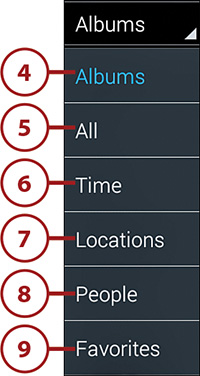
10. Close the menu by tapping the Back touch button.
12. Tap to select one or more complete albums to stream to another device, share, or delete. On the Gallery home screen, you can also hold your finger on an album cover photo for a few seconds to select it.
13. Tap to view a slideshow of photos. The first frame of any video that you have shot also plays in the slideshow. You can tap the screen again to stop the slideshow.
14. Tap to view all albums by All Content, Content in Device, Content in Dropbox, Content in Facebook, or Content in Picasa.
15. Tap to share photos with nearby devices, such as a friend’s smartphone.
16. Close the menu by tapping the Back touch button.
17. Tap an album to view all photos in it.

18. After you have captured many photos and videos, the thumbnail representation of images in this category becomes long. Flick the screen up and down to view all thumbnails in the album.
19. Tap the Camera icon to capture another photo.
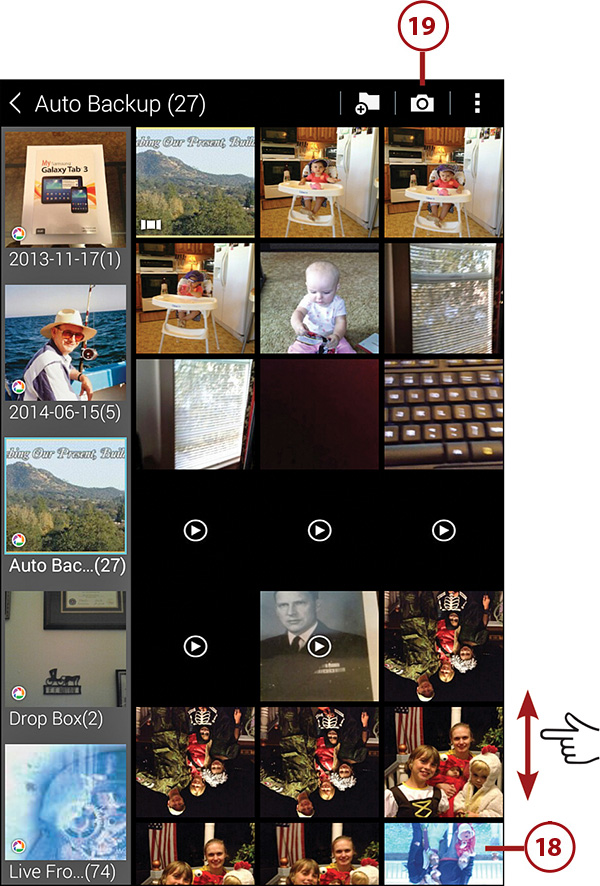
20. Tap the Menu icon to reveal the options Select Item and Slideshow. Select Item enables you to select one or more items that you want to stream to another device, share, or delete. The Slideshow option enables you to view a slideshow of pictures within the album.
21. Touch and hold your finger to a photo to reveal more Gallery options.
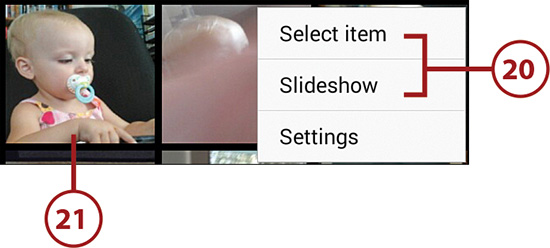
22. To delete images within an album, touch each image you want to delete (the check box in the upper-right corner of the image is checked) and then tap the Trash icon.
23. You can touch the number of selected images to reveal the option to Select All photos in the album.
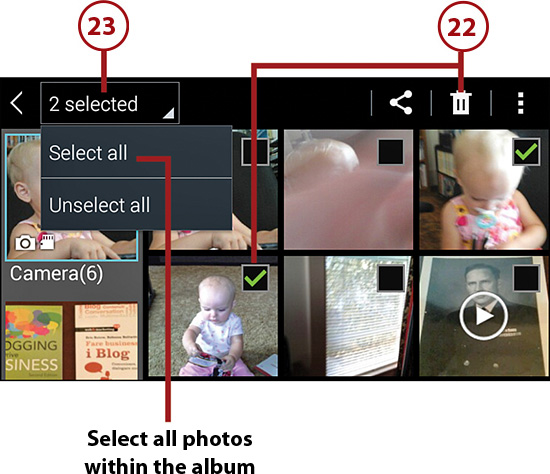
24. Tap the Menu icon and then tap Slideshow to show your selected photos as a slideshow.
25. Tap to copy or move your photos to a different album or to your external SD card.
26. Tap the Share icon to view options for sharing the displayed image with friends and family via ChatON, Dropbox, to another device using a Bluetooth connection, your Google Drive account, email, or post the photo or video on your Flipboard account. Swipe down the window to view more sharing options including Gmail, Google+, Hangouts, placing the photo or video in a memo, sharing in the Picasa and Photos apps, or sharing with another device using a Wi-Fi Direct connection.
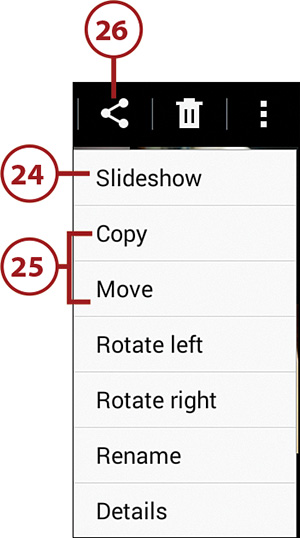
27. Turn off the image selection feature by tapping the Back touch button, and then tap a photo in the album to open it full screen.
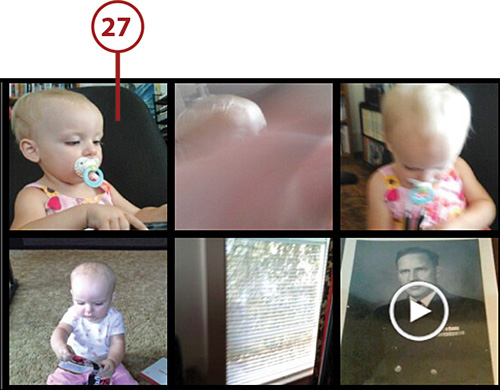
28. Touch the middle of the screen to reveal the controls and then tap the left arrow icon in the menu bar to return to the previous screen.

Email Photos from Gallery
Emailing your photos to friends and family can be accomplished in just a few taps on your Galaxy Tab 4.
1. Open the album that has the photo you want to email, and then touch and hold your finger to that photo to access more Gallery options.
2. Touch more photos that you want to share. A green check mark appears within the check box that appears in the upper-right corner of each photo, letting you know that it is selected. Email providers have varying file size limitations, so make sure you are aware of your provider’s limitations before emailing photographs.
3. Tap the Share icon to access the options in the Share Via menu. You can access these same Share options even if you are viewing a single photo in full screen mode.
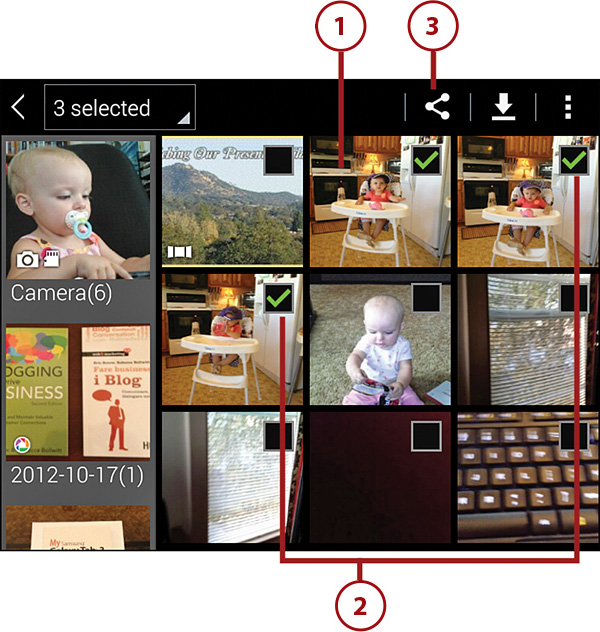
4. Tap the Gmail app icon or Email. This example uses Gmail. The Gmail application opens with the images you selected attached. Note that you don’t see the actual images but an image icon with the image filename and size.
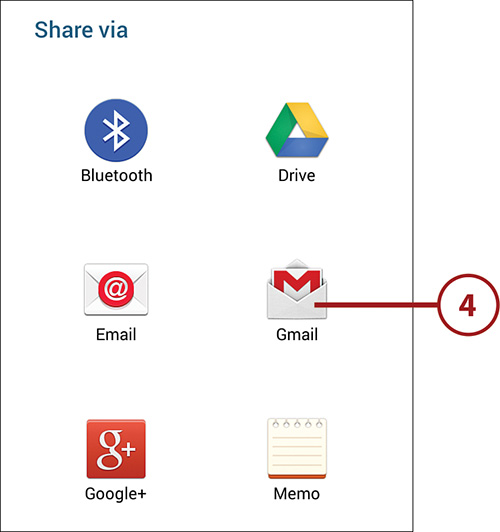
5. Tap the X located at the bottom-right corner of a photo to remove the attachment. Keep in mind that you do not have the option to attach a new image at this stage, if you choose to remove an attachment.
6. Type the recipient’s email address into the To field. If you see the name of the recipient in the drop-down list as you type, tap the name of the recipient. After you add a recipient to the list, you can add another one by typing the recipient name; you don’t need any separator characters, such as a semicolon.
7. Tap in the Subject field and then type a subject for the email.
8. Tap in the Compose Email field to compose a message.
9. Tap Send to send the message.
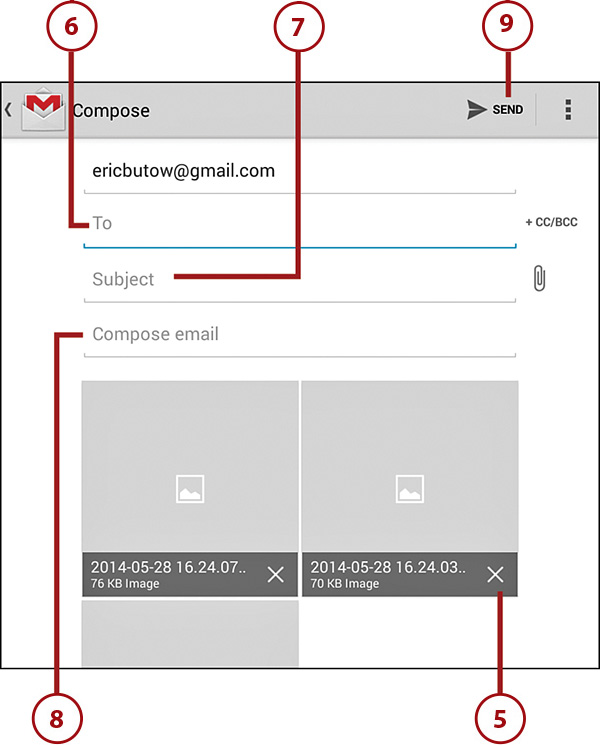
Creating Screen Captures
You Galaxy Tab 4 has a very helpful feature that enables you to take screen captures of its interface. The ability to take screenshots can come in handy for educational purposes, especially if you want to post a few Galaxy Tab tips online.
1. Open the screen that you want to take the screen shot of and position the Tab into the orientation in which you want to grab the screen capture: vertical or horizontal.
2. Press and hold the Power button and Home button at the same time. You hear the shutter sound effect as it takes the screen capture.
3. The screenshot is saved to the Screenshots folder in the Gallery app, and the image is also saved to the clipboard.
